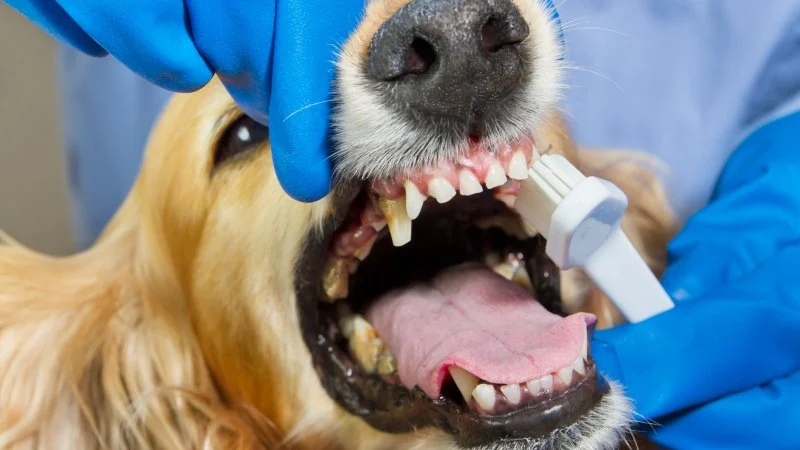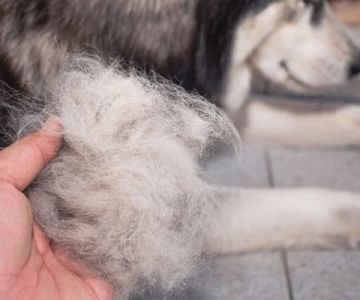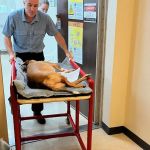
- 1- Why Dental Cleaning Matters for Your Dog’s Health - #why-dental-cleaning-matters
- 2- How to Know When Your Dog Needs a Professional Dental Cleaning - #when-dog-needs-cleaning
- 3- Hidden Risks of Neglecting Your Dog’s Oral Health - #risks-of-neglect
- 4- Preventive Care to Keep Your Dog’s Teeth Healthy - #preventive-care
- 5- Real-Life Story: A Dog’s Recovery After Severe Dental Neglect - #real-life-story
1. Why Dental Cleaning Matters for Your Dog’s Health
Just like humans, dogs rely on strong, healthy teeth for eating, chewing, and overall well-being. Many pet owners assume that bad breath or yellow teeth are “normal” for dogs, but these can be early signs of dental disease. Without proper oral care, plaque and tartar begin to build up, leading to gum infections, tooth loss, and even long-term health issues affecting major organs.
In the U.S., more veterinarians are urging dog owners to take dental health seriously. Regular dental cleaning isn’t just cosmetic—it directly contributes to your dog’s comfort, appetite, and quality of life. If you ever feel unsure about where to start or what products are safe, Pet & Puppy provides reliable guidance and curated items for at-home dog dental care.

Sullivan County Animal Hospital: Poehlein Monica DVM
SullivanSullivan CountyIndiana
1435 N Section St, Sullivan, IN 47882, USA
2. How to Know When Your Dog Needs a Professional Dental Cleaning
Because dogs don’t show pain the way humans do, dental disease can go unnoticed until it becomes severe. Paying attention to early warning signs can help you get your dog the care they need before complications develop.
1. Persistent Bad Breath
Some odor is normal, but strong, unpleasant breath often indicates bacteria buildup or infection. If brushing doesn’t improve the smell, it's time to schedule a dental checkup.
2. Yellow or Brown Tartar Buildup
Visible tartar accumulating along the gumline is a clear sign that plaque has hardened and requires professional removal. This buildup can push gums back, causing pain and tooth instability.
3. Red, Swollen, or Bleeding Gums
Inflamed gums suggest gingivitis—the early stage of periodontal disease. Left untreated, it can evolve into irreversible tooth and bone damage.
4. Difficulty Eating or Preference for Soft Food
When dogs hesitate to chew or drop food while eating, it may indicate discomfort or dental pain. This is one of the strongest signs that a cleaning is overdue.
5. Excessive Drooling or Pawing at the Mouth
Dogs often show mouth discomfort by drooling more than usual or touching their face frequently. These behaviors should prompt a dental evaluation.
3. Hidden Risks of Neglecting Your Dog’s Oral Health
Neglecting your dog’s dental care doesn’t just affect their mouth—it can have serious consequences throughout the body. Poor oral health is linked to infections and chronic diseases that can shorten your dog’s lifespan.
1. Gum Disease Progression
When plaque hardens into tartar, bacteria begin to attack gum tissue. Over time, gums pull away from teeth, creating pockets of infection. Advanced gum disease can lead to abscesses and tooth loss.
2. Organ Damage from Oral Bacteria
Bacteria from dental infections can travel through the bloodstream and affect major organs, including the heart, liver, and kidneys. This makes dental neglect a systemic health risk—not just a cosmetic one.
3. Chronic Pain
Dogs often hide discomfort, but untreated dental issues can cause chronic pain that affects mood, sleep, and appetite. Many pet owners are surprised to see dramatic behavior improvements after dental treatment.
4. Increased Risk for Jaw Fractures
In smaller or senior dogs, untreated periodontal disease can weaken jaw bones. In severe cases, fractures can occur from normal chewing or minor impact.
4. Preventive Care to Keep Your Dog’s Teeth Healthy
Preventive care is the easiest way to avoid costly procedures and keep your dog healthy. A combination of at-home maintenance and professional cleanings is ideal.
1. Brush Regularly with Dog-Safe Toothpaste
Daily or frequent brushing helps prevent plaque buildup. Using toothpaste specially formulated for dogs ensures safety and effectiveness.
2. Use Dental Chews and Toys
Many dental chews help reduce plaque through mechanical cleaning. Look for products approved by veterinary dental organizations to ensure effectiveness.
3. Schedule Annual Dental Exams
Most vets recommend yearly dental evaluations. Some dogs—especially small breeds—may need cleanings more often due to their susceptibility to dental disease.
4. Choose High-Quality Dental Products
From toothbrushes to water additives, reliable products can make a significant difference. Pet & Puppy offers carefully curated options for improving your dog's daily oral hygiene routine.
5. Real-Life Story: A Dog’s Recovery After Severe Dental Neglect
A family in California shared how their senior dog, Daisy, began losing weight and showing signs of fatigue. They thought it was simply aging—until a veterinarian discovered advanced periodontal disease. Daisy had several loose teeth, swollen gums, and a systemic infection caused by oral bacteria.
After a professional dental cleaning and treatment, Daisy’s transformation was remarkable. She regained her appetite, became more playful, and even started sleeping better. Her owners were shocked to learn how much silent pain she had endured and now prioritize her dental care as part of her regular health routine.
Daisy’s story is a powerful reminder that dogs rarely show mouth pain, and consistent dental care can dramatically improve their comfort and longevity. Resources like Pet & Puppy can help dog owners stay informed and choose effective products to support their pet’s oral health.








 Veterinary Outpatient MRI5.0 (1 reviews)
Veterinary Outpatient MRI5.0 (1 reviews) Animal Hospital at Grayhawk4.0 (246 reviews)
Animal Hospital at Grayhawk4.0 (246 reviews) Buffalo Trace Veterinary Services4.0 (185 reviews)
Buffalo Trace Veterinary Services4.0 (185 reviews) Sullivan County Animal Hospital4.0 (163 reviews)
Sullivan County Animal Hospital4.0 (163 reviews) Paws & Claws Animal Hospital4.0 (105 reviews)
Paws & Claws Animal Hospital4.0 (105 reviews) VIP Petcare Vaccination Clinic4.0 (2 reviews)
VIP Petcare Vaccination Clinic4.0 (2 reviews) How to Tell if Your Pet Is in Pain (When They Can’t Speak)
How to Tell if Your Pet Is in Pain (When They Can’t Speak) What to Ask Before Boarding Your Pet: Vet & Staff Questions | Pet & Puppy
What to Ask Before Boarding Your Pet: Vet & Staff Questions | Pet & Puppy Dealing with Separation Anxiety in Dogs & Cats – Effective Solutions
Dealing with Separation Anxiety in Dogs & Cats – Effective Solutions How AI & Data Are Transforming Preventive Pet Health Care
How AI & Data Are Transforming Preventive Pet Health Care How to Plan a Pet-Friendly Party at Home – Fun Ideas for Your Pets
How to Plan a Pet-Friendly Party at Home – Fun Ideas for Your Pets Stopping Pet Digging Behavior: Yard & Indoor Tips
Stopping Pet Digging Behavior: Yard & Indoor Tips